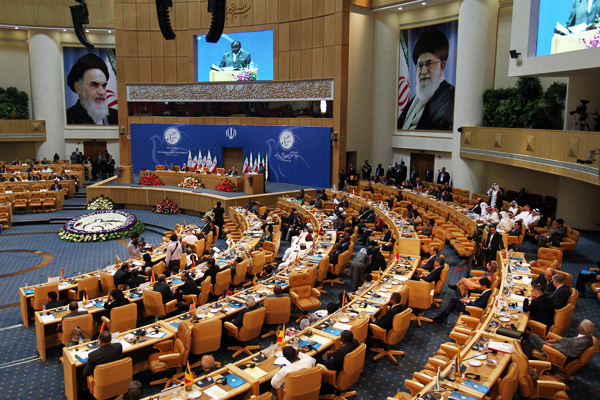
Amid the 16th Non-Aligned Movement (NAM) conference, the biggest gathering of international dignitaries in the Islamic Republic’s 33-year history, northern Tehran has become a ghost town. “I’ve been waiting for a cab for 10 minutes,” says a resident of the capital, staring down the city’s main thoroughfare, the usually jammed Vali-Asr Boulevard, almost completely deserted.
He curses at two cabs that zip past, ignoring his desperate cries for a “darbast taxi,” or a private, single-passenger ride. That sort of ride comes at a premium — and cabbies are usually eager to take advantage of darbast customers. But the few taxis he encounters are all occupied. With the NAM-related restrictions on traffic, cabs have become a precious commodity in the north these days.
Saturday marks the end of a five-day, state-sanctioned holiday exclusively for Tehran to clear out Iran’s capital for the NAM conference. Government buildings, banks and many businesses locked up, residents were encouraged to leave the city, highway entrances were occasionally cordoned off, and 110,000 servicemen were summoned to the capital and positioned mere meters apart from one another to enhance security.
“Since the revolution, Iran has never had a conference of this size,” says Firouzeh, a northern Tehran resident, referring to government efforts to dramatically reduce traffic and keep streets clean to impress the visiting diplomats and journalists. But she says the methods are familiar. “The controlled atmosphere and the police officers are nothing new for us,” she explains, recalling the heightened-security atmosphere that was put in place after the violent crackdown on the so-called Green democracy movement after the controversial 2009 vote that saw Mahmoud Ahmadinejad re-elected to the presidency.
The capital went into deeper lockdown on Thursday when numerous heads of state, including U.N. Secretary-General Ban Ki-moon and newly elected Egyptian President Mohamed Morsy, arrived. Several of the city’s most important roads and highways, including the widely used Chamran expressway, were completely closed off to those without government permits. The usually bustling Parkway intersection, adjacent to the hotel where most of the delegates are believed to be staying, was eerily empty. One resident claimed he hadn’t seen Tehran this vacant since the 1980s, when people stayed off the streets and sought refuge in sturdily built concrete apartments when Saddam Hussein’s barrage of missiles bombarded the city during the Iran-Iraq war.
But the current shutdown reflects the government’s desire to present an appearance of order in the face draconian economic sanctions by the West over Iran’s nuclear program. NAM provides Iran with an audience in Tehran of nearly two-thirds of U.N.’s member states to project a positive self-image. It was evident weeks before the conference that the regime was pulling out all the stops. City workers could be seen repainting many of the city’s trademark green-and-white curbs, fences and lampposts, and rumors circulated about just how many thousands of dollars (i.e., “millions of tomans”) had been given to northern Tehran families to persuade them to take five-day trips for the duration of the conference in an effort to vacate the neighborhood near the conference hall, both for security reasons and to ease traffic. “We predict a big wave of trips originating from Tehran, and we’ve taken the necessary steps to accommodate that,” said Shahriar Afandizadeh, head of Iran’s Road Maintenance and Transportation Organization, before the holiday.
The sprucing up is all for the foreigners’ comfort. The Chamran and Modares expressways are decorated with floral arrangements and banners that read “Welcome” in Arabic, English and Farsi. The government has gotten its hands on dozens of black S-500 Mercedes Benzes to ferry the diplomatic visitors around town at all hours. If Tehran’s esteemed guests decide to venture underground into the city’s ever expanding metro, the city’s northernmost and largest station now features an elaborate display of photographs from Bahrain, Yemen and Egypt’s “Islamic Awakening,” the term used by the Iranian establishment to describe the Arab Spring. (Accommodating regional visitors goes only so far; the Persian Gulf is labeled so — nothing Arab about it except the countries on its southern littoral.)
The government has even attended to visually unappealing parts of the city that diplomats are unlikely to visit. The Sadr highway, whose double-deckering is perhaps Tehran’s most in-your-face construction project at this point, is now fronted by a message from the Supreme Leader about overcoming challenges via Islam to develop the nation. The highway’s disjointed segments, however, are still in disarray above.
Some locals have joked about how this megacity must shut down to function. After all, they say, New York City isn’t closed 24 hours a day, seven days a week even though the U.N. headquarters teems daily with foreign dignitaries and diplomats. But many Tehran residents are proud that an event like NAM is being held in their city and hope more like it will be held more frequently, if only to tidy up more neighborhoods in the capital.
More Must-Reads from TIME
- Cybersecurity Experts Are Sounding the Alarm on DOGE
- Meet the 2025 Women of the Year
- The Harsh Truth About Disability Inclusion
- Why Do More Young Adults Have Cancer?
- Colman Domingo Leads With Radical Love
- How to Get Better at Doing Things Alone
- Michelle Zauner Stares Down the Darkness
Contact us at letters@time.com